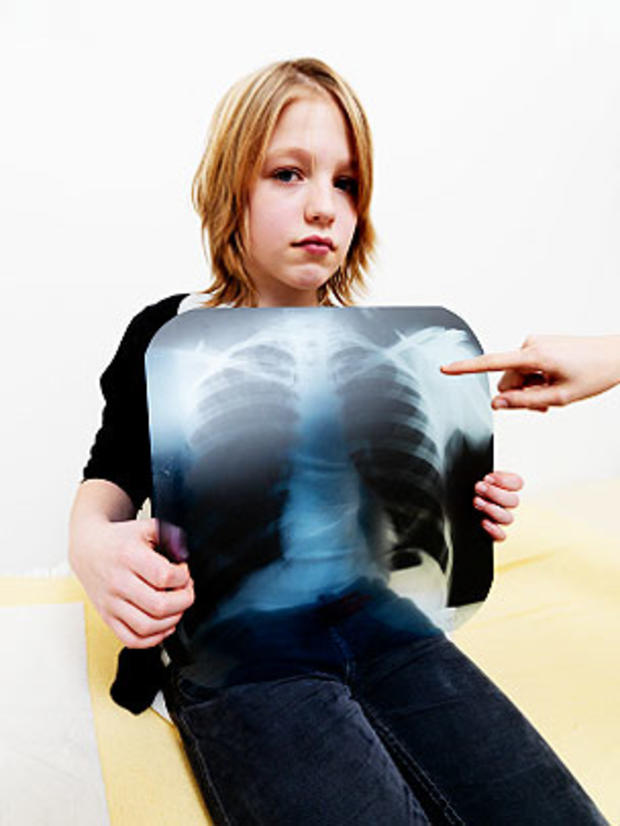FDA proposes guidelines to reduce radiation exposure during kids' X-rays, CT scans
(CBS/AP) Millions of children undergo an X-ray each year. The U.S. Food and Drug Administration wants to make sure these kids aren't getting too much radiation, and have called on manufacturers to design the safest models possible.
Yearly dental X-rays raise brain tumor risk, study finds
Radiation exposure has long been a concern when it comes to cancer risk, but children are believed to be especially vulnerable because their brains are still growing.
Wednesday, the FDA proposed guidelines for scanners that are safe for the youngest, smallest patients and put new advice on its website to teach parents what to ask about these increasingly common tests.
"We are trying to ensure that patients get the right dose at the right time, and the right exam," FDA physicist Thalia Mills told The Associated Press.
The use of CT scans, which show more detail than standard X-rays but entail far more radiation, and other medical imaging has soared in recent years. Such tests can be lifesaving, and specialists say people who really need one shouldn't avoid it for radiation fears.
But research shows too often the scans are unnecessary - they're given too frequently, for example, or in place of other tests that don't emit radiation. A study last year found doctors are too quick to prescribe a CT scan to rule out a traumatic brain injury for kids who experience head trauma, HealthPopreported, when only a small percentage of kids have a serious problem.
Another study found an average child will receive more than seven radiation-emitting scans by age 18.
And while pediatric hospitals routinely adjust scanner doses for youngsters' smaller sizes, 90 percent of child imaging is performed in general hospitals - and the FDA said no one knows how many make those adjustments.
That's the goal of Wednesday's guidelines: "Regardless if my child is imaged at a pediatric hospital or a local community hospital, they get the same basic care," said FDA biomedical engineer Jana Delfino. "Everybody should be able to do it."
Dr. Marilyn Goske of Cincinnati Children's Hospital praised the long-awaited move, saying, "It puts the spotlight on children." Goske chairs the Alliance for Radiation Safety in Pediatric Imaging, which runs the "Image Gently" campaign, a voluntary program that in the past few years has helped teach health providers how to use these tests more safely in children, with child-size dosing and other steps such as shielding vulnerable organs from the beam. But she says further improvements are needed.
While the guidelines wouldn't require changes to existing scanners, those eventually would be upgraded and fall under the same standards. The FDA said in an emailed statement to CBS News that the guidelines are open for public comment for four months before the agency will finalize them.
Doctors don't keep track of how much radiation their patients receive from testing - they simply order a scan, and how much radiation results can vary widely by the age and brand of machine. It also depends on the possible diagnosis: An average head CT for an adult is equal to about 100 chest X-rays, the FDA says, while a CT of the abdomen brings even more.
But radiologists don't always need the crispest image. Often it's possible to successfully diagnose while using a fraction of the typical radiation dose, said Dr. Marta Hernanz-Schulman of Vanderbilt University, who chairs the American College of Radiology's pediatric imaging commission.
While there's no generally accepted safe lifetime radiation dose for children, Schulman tells parents to keep a list of their child's medical scans - and pull it out every time a doctor considers ordering another one. That's especially helpful for children with chronic diseases who truly need more medical scans than the average youngster.
Under the FDA's proposed guidelines, manufacturers of new medical imaging devices would have to provide specific information on how to minimize radiation exposure for children of different ages and sizes - or label their scanner not for pediatric use. The guidelines also encourage push-of-a-button dose adjustments and software to remind the medical technician to make them.
For parents, the FDA is publishing advice that includes a list of questions to ask to make sure your child is getting the best test. The recommendations:
- Ask the doctor who orders a scan how it will improve the child's care and whether there are alternatives that don't use radiation.
- Ask the imaging facility whether it uses reduced radiation techniques for children.
The FDA also is urging doctors to consider how many scans the child already has had and the possibility of alternatives before ordering another test. MRI scans and ultrasound, for example, don't emit radiation.
"It's something you need to use conscientiously," Schulman said of the scans. "Any radiation you don't need is radiation you shouldn't get."
The FDA has more information on pediatric X-rays.
